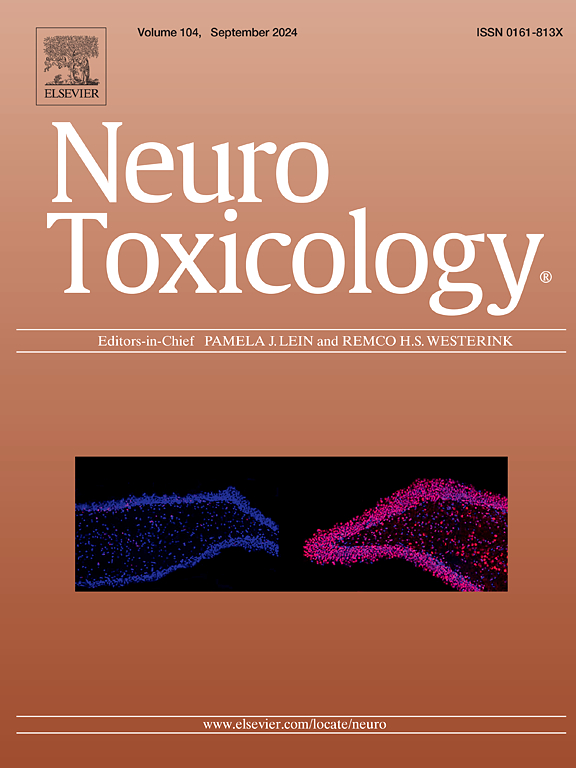Chronic cisplatin treatment in young mice induces long-term complications in the peripheral nervous system in a sex-dependent manner
IF 3.9
3区 医学
Q2 NEUROSCIENCES
引用次数: 0
Abstract
Cisplatin-induced peripheral neuropathy (CIPN) is one of the most prevalent long-term complications in pediatric cancer survivors reaching adulthood. However, very few studies have evaluated the long-term effects of cisplatin administered to the young population on the peripheral nervous system and assessed whether these effects are sex-dependent. Thus, we aimed to assess baseline mechanical withdrawal thresholds (a CIPN measurement), the density of CGRP+ and PGP9.5+ axons in the glabrous skin, changes in different markers in DRG, and determine pain-like responses after intra-plantar capsaicin in female and male mice at 4 weeks after cessation of cisplatin. Four-week-old BALB/c mice were treated with cisplatin (4 mg/kg, intraperitoneally, twice weekly for 4 weeks). Four weeks after cessation of cisplatin, these mice, at 12 weeks of age, exhibited significant hindpaw mechanical hypersensitivity, which was greater in magnitude in female mice compared to male mice. At 13 weeks old, cisplatin-treated mice also had a greater density of CGRP+ and PGP9.5+ intraepidermal nerve fibers compared to saline-treated groups in female and male mice, independent of sex. The number of CGRP+ and ATF3+ neuronal profiles and CD68+ monocyte/macrophage in L4 DRG was higher in cisplatin-treated mice than in saline-treated mice, independent of sex. Intra-plantar capsaicin injection in adult mice resulted in greater and longer flinching and guarding behaviors in cisplatin-pretreated mice compared to saline-pretreated mice. The enhanced capsaicin-induced pain behaviors were significantly greater in female compared to male mice. These findings demonstrate long-term, partially sex-related complications in the peripheral nervous system following cisplatin treatment.
慢性顺铂治疗在年轻小鼠诱导周围神经系统以性别依赖的方式长期并发症。
顺铂诱导的周围神经病变(CIPN)是儿童癌症幸存者成年后最常见的长期并发症之一。然而,很少有研究评估顺铂对年轻人周围神经系统的长期影响,并评估这些影响是否具有性别依赖性。因此,我们旨在评估基线机械戒断阈值(CIPN测量),无毛皮肤中CGRP+和PGP9.5+轴突的密度,DRG中不同标记物的变化,并确定顺铂停药后4周雌性和雄性小鼠脚底辣椒素后的疼痛样反应。顺铂治疗4周龄BALB/c小鼠(4mg/kg,腹腔注射,每周2次,连续4周)。停止顺铂治疗4周后,这些小鼠在12周龄时表现出明显的后爪机械过敏,雌性小鼠比雄性小鼠的程度更大。在13周龄时,顺铂处理的小鼠表皮内神经纤维的CGRP+和PGP9.5+密度也高于盐水处理的雌性和雄性小鼠,与性别无关。顺铂处理小鼠L4 DRG中CGRP+和ATF3+神经元分布和CD68+单核/巨噬细胞的数量高于盐水处理小鼠,与性别无关。成年小鼠足底内注射辣椒素导致顺铂预处理小鼠比盐水预处理小鼠退缩和守卫行为更大,时间更长。与雄性小鼠相比,雌性小鼠辣椒素诱导的疼痛行为明显增强。这些发现表明顺铂治疗后周围神经系统存在长期的、部分性相关的并发症。
本文章由计算机程序翻译,如有差异,请以英文原文为准。
求助全文
约1分钟内获得全文
求助全文
来源期刊

Neurotoxicology
医学-毒理学
CiteScore
6.80
自引率
5.90%
发文量
161
审稿时长
70 days
期刊介绍:
NeuroToxicology specializes in publishing the best peer-reviewed original research papers dealing with the effects of toxic substances on the nervous system of humans and experimental animals of all ages. The Journal emphasizes papers dealing with the neurotoxic effects of environmentally significant chemical hazards, manufactured drugs and naturally occurring compounds.
 求助内容:
求助内容: 应助结果提醒方式:
应助结果提醒方式:


